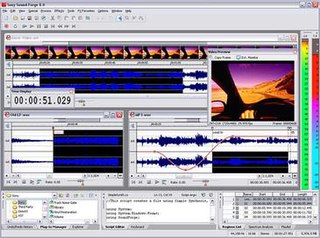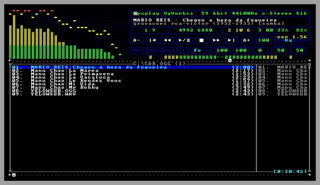Related Research Articles
An audio file format is a file format for storing digital audio data on a computer system. The bit layout of the audio data is called the audio coding format and can be uncompressed, or compressed to reduce the file size, often using lossy compression. The data can be a raw bitstream in an audio coding format, but it is usually embedded in a container format or an audio data format with defined storage layer.
Waveform Audio File Format is an audio file format standard, developed by IBM and Microsoft, for storing an audio bitstream on PCs. It is the main format used on Microsoft Windows systems for uncompressed audio. The usual bitstream encoding is the linear pulse-code modulation (LPCM) format.
Audio Video Interleave, is a proprietary multimedia container format and Windows standard introduced by Microsoft in November 1992 as part of its Video for Windows software. AVI files can contain both audio and video data in a file container that allows synchronous audio-with-video playback. Like the DVD video format, AVI files support multiple streaming audio and video, although these features are seldom used.
Audio Interchange File Format (AIFF) is an audio file format standard used for storing sound data for personal computers and other electronic audio devices. The format was developed by Apple Inc. in 1988 based on Electronic Arts' Interchange File Format and is most commonly used on Apple Macintosh computer systems.
The Resource Interchange File Format (RIFF) is a generic file container format for storing data in tagged chunks. It is primarily used to store multimedia such as sound and video, though it may also be used to store any arbitrary data.
MPEG-1 Audio Layer II or MPEG-2 Audio Layer II is a lossy audio compression format defined by ISO/IEC 11172-3 alongside MPEG-1 Audio Layer I and MPEG-1 Audio Layer III (MP3). While MP3 is much more popular for PC and Internet applications, MP2 remains a dominant standard for audio broadcasting.

Surround sound is a technique for enriching the fidelity and depth of sound reproduction by using multiple audio channels from speakers that surround the listener. Its first application was in movie theaters. Prior to surround sound, theater sound systems commonly had three screen channels of sound that played from three loudspeakers located in front of the audience. Surround sound adds one or more channels from loudspeakers to the side or behind the listener that are able to create the sensation of sound coming from any horizontal direction around the listener.
8-Bit Sampled Voice (8SVX) is an audio file format standard developed by Electronic Arts for the Commodore-Amiga computer series. It is a data subtype of the IFF file container format. It typically contains linear pulse-code modulation (LPCM) digital audio.

Pro Tools is a digital audio workstation (DAW) developed and released by Avid Technology for Microsoft Windows and macOS. It is used for music creation and production, sound for picture and, more generally, sound recording, editing, and mastering processes.

5.1 surround sound is the common name for surround sound audio systems. 5.1 is the most commonly used layout in home theatres. It uses five full bandwidth channels and one low-frequency effects channel. Dolby Digital, Dolby Pro Logic II, DTS, SDDS, and THX are all common 5.1 systems. 5.1 is also the standard surround sound audio component of digital broadcast and music.
WavPack is a free and open-source lossless audio compression format and application implementing the format. It is unique in the way that it supports hybrid audio compression alongside normal compression which is similar to how FLAC works. It also supports compressing a wide variety of lossless formats, including various variants of PCM and also DSD as used in SACDs, together with its support for surround audio.
A container format or metafile is a file format that allows multiple data streams to be embedded into a single file, usually along with metadata for identifying and further detailing those streams. Notable examples of container formats include archive files and formats used for multimedia playback. Among the earliest cross-platform container formats were Distinguished Encoding Rules and the 1985 Interchange File Format.

Sound Forge is a digital audio editing suite by Magix Software GmbH, which is aimed at the professional and semi-professional markets. There are two versions of Sound Forge: Sound Forge Pro 12 released in April 2018 and Sound Forge Audio Studio 13 released in January 2019. Both are well known digital audio editors and offer recording, audio editing, audio mastering and processing.
Broadcast Wave Format (BWF) is an extension of the popular Microsoft WAV audio format and is the recording format of most file-based non-linear digital recorders used for motion picture, radio and television production. It was first specified by the European Broadcasting Union in 1997, and updated in 2001 and 2003. It has been accepted as the ITU recommendation ITU-R BS.1352-3, Annex 1.
An NRG file is a proprietary optical disc image file format originally created by Nero AG for the Nero Burning ROM utility. It is used to store disc images. Other than Nero Burning ROM, however, a variety of software titles can use these image files. For example, Alcohol 120%, or Daemon Tools can mount NRG files onto virtual drives for reading.
iXML is an open standard for the inclusion of location sound metadata in Broadcast Wave audio files, video files and also IP video and audio streams. This includes things like Scene, Take and Notes information.
The Core Audio Format is a container for storing audio, developed by Apple Inc. It is compatible with Mac OS X 10.4 and higher; Mac OS X 10.3 needs QuickTime 7 to be installed.

Mpxplay is a 32-bit console audio player for MS-DOS and Windows. It supports a wide range of audio codecs, playlists, as well as containers for video formats. The MS-DOS version uses a 32-bit DOS extender.
Adaptive differential pulse-code modulation (ADPCM) is a variant of differential pulse-code modulation (DPCM) that varies the size of the quantization step, to allow further reduction of the required data bandwidth for a given signal-to-noise ratio.
Pulse-code modulation (PCM) is a method used to digitally represent sampled analog signals. It is the standard form of digital audio in computers, compact discs, digital telephony and other digital audio applications. In a PCM stream, the amplitude of the analog signal is sampled regularly at uniform intervals, and each sample is quantized to the nearest value within a range of digital steps.